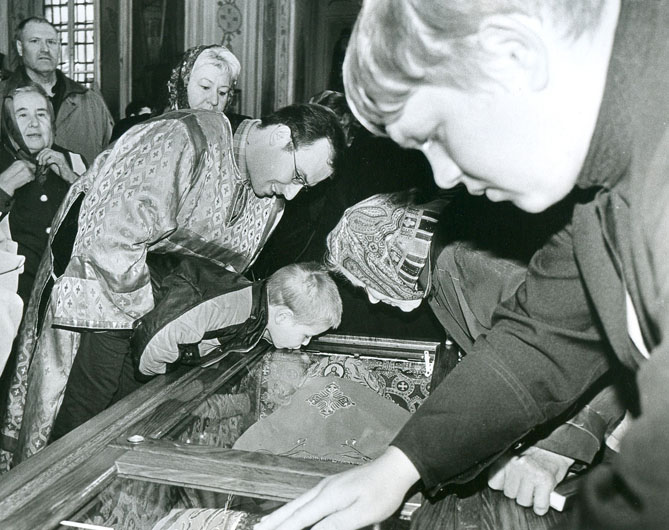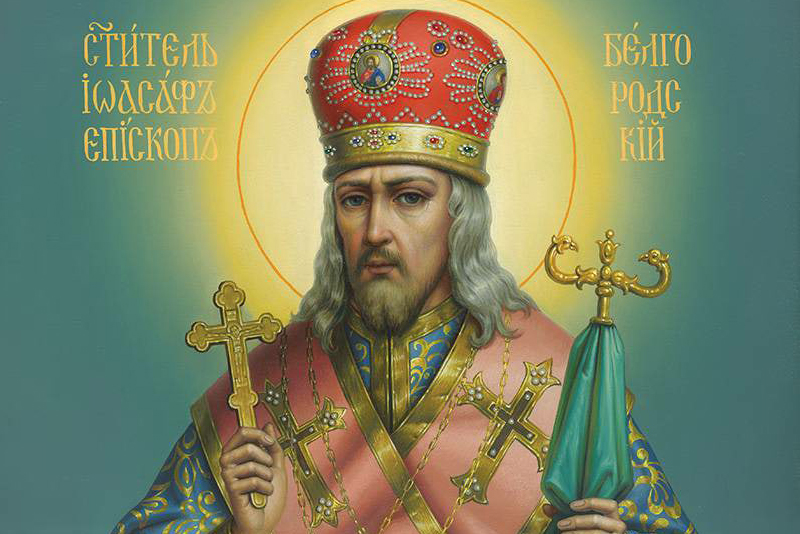
Saint Nicholas, Archbishop of Myra, is a known Christian saint famous for his anonymous acts of charity. Saint Joasaph of Belgorod is less famous worldwide, but he is still a widely revered saint in Russia. He lived in the 18th century. By his righteous life, honourable deeds and posthumous miracles he likened himself in many ways to Saint Nicholas the Wonderworker, as if he was following in his footsteps. Let us recall several episodes characteristic of the saint’s life.
Childhood
In the world, Saint Joasaph was named Joachim in honour of the father of the Holy Theotokos. He was born into a wealthy, noble and pious family. When Joachim was a small boy, his father had a vision of the Holy Theotokos that preordained his son’s future life. He as sitting at sunset at the door of his house looking at the sky when he saw the Most Pure Theotokos on a cloud. His son was standing at her feet. The Holy Mother of God said to the boy: “Your prayer pleases me,” and immediately an angel covered the boy with an archbishop’s mantle. His vision ended. The father rushed into the house to tell his wife, but could not remember anything when he found her. He did not remember his vision until many years later.
Secret almsgiving
As a bishop, Saint Joasaph aided the poor by giving alms in secret. On big church feasts, he prepared gifts for the poor families and sent his lay brother to deliver them by night.
One Christmas eve, the lay brother was ill, and could not deliver the presents. The saint was unwilling to engage somebody else, and in the middle of the night, he went to distribute the bags himself. As he was returning to his chambers, a guard stopped him. The saint was not answering any questions so the guard would not recognise him. Taking him for a thief or an impudent pauper trying to break into the archbishop’s house, he began to strike the stranger with his club to turn him away. But when he saw the bishop’s face, he stepped back in shock and awe, while he bishop disappeared quickly in his chambers. In the morning, the guard came to the bishop expecting punishment, but instead, he was rewarded generously for being watchful.
Sometimes, the Lord revealed the name of the alms giver to the recipients of his gifts in response to their vehement prayers. Saint Joasaph was helping a poor widow. He sent someone on a horse-driven cart to bring her firewood and instructed him not to tell his name under any circumstances. The widow asked God to reveal to her the name of her benefactor so she could pray for him. One night, as she was praying, she saw a vision of Saint Joasaph of Belgorod.

Bishop’s ministry
Saint Joasaph was strict to himself and demanding of others. Many of his contemporary acknowledged that throughout his service as an archbishop, the morale in Belgorod and its environs improved remarkably. Tirelessly, Saint Joasaph was touring the villages and churches in the most remote corners and to talk to and educate the people. He was working to eradicate the remnants of paganism among laypeople and to combat heavy drinking among the clergy. He disfrocked the clergy and banished the assistants for coming to church drunk. He handed out strict punishments for breaking the rules of the Church, and sometimes the Lord revealed to him the transgressions that escaped his eye. As he was staying for the night at the house of a parish priest, he could not go to sleep for a long time. He was feeling anxious and apprehensive. When he went into the kitchen, he noticed among the tableware and food the vessels with the consecrated bread and wine wrapped in a piece of paper. To protect the holy gifts from inadvertent desecration, all clergy were required to safe keep them with great piety in a designated bag away from everyday objects. The saint prayed before the Holy Gifts all night, and in the morning the negligent priest was disfrocked.
The discovery of a wonderworking icon
One day, Saint Joasaph had a miraculous vision of a shining icon of the Holy Theotokos placed in a remote corner amid a stack of waste. In the vision, the Holy Theotokos said to him: “Look what the clergy of this church has done to my depiction. It was destined to shed God’s grace on people, and they have covered it in dust and waste!”
The saint looked vigorously for the icon until he finally discovered it in a church in the city of Izyum. The icon of the Theotokos had been put in the corner of the church vestibule and lay in a layer of ash from the incensory. The saint kneeled before the icon and prayed tearfully and vehemently to the Theotokos for her forgiveness of the negligent clergy. Then he placed inside the Church, telling the people that with this icon the Holy Theotokos was interceding for all Russia. Since then, there have been many miracles attributed to the newly discovered icon, which became known as the Icon of the Sand.

The power of prayer
One summer, just before the summer feast of the Holy Trinity, the residents of Ugrium Hamlet approached saint Joasaph asking him to pray for some rain. The great number of pests that had bred during the spell of dry weather was threatening to destroy all of their crops. The bishop listened and asked his coacher to ready a sledge for the next day to travel to the hamlet. The people did not know what to think, as it was scorching hot outside. The next morning, however, it snowed, and the snow soaked the fields with water and saved the crop.
Posthumous miracles

Saint Joasaph knew the time of his death. He had time to give the last instructions to his flock in Belgorod and bid farewell to his family. The good bishop Joasaph departed to God in 1754 at age 49. After his death, the body of the saint lay incorrupt for three months awaiting interment. The conditions prevented the local bishop from coming to perform the burial service. After two years of being put to rest, the saint’s relics were still found incorrupt.
From the day of his death, people had been worshipping his relics without waiting for his canonisation, and they had their pleas and prayers heard. By the time of his glorification as a saint in 1911, some 400 instances of miracles had been reported, attributed to the saint’s intercession. Reports of the miracles have continued to this day.
Saint Joasaph is one of the most favoured saints among children. He will intercede on their behalf to give them healing from some of the most hard-to-treat illnesses. Ever since early childhood, the saint had followed the thorny path of service to God as a monastic, and he has taken great care to listen to petitions from children or on their behalf when his name is invoked.





